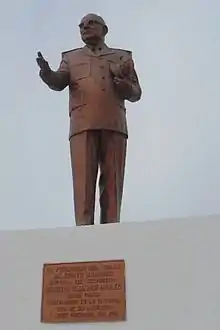Agustín Olachea
José Agustín Olachea Avilés (September 3, 1890, Todos Santos, Baja California Sur – April 13, 1974, La Paz, Baja California Sur) was a Mexican general[1] who supported Lázaro Cárdenas for president.[2] During the Cárdenas years he served as Governor of the Federal North Territory of Baja California, having previously filled the same post for Baja California Sur as a member of the social-democratic Institutional Revolutionary Party. This second gubernatorial term came during a period of rising hostility toward the Chinese population in Mexicali.[3] Later, Olachea Avilés acted as Secretary of Defense under Adolfo López Mateos.[4]
Agustín Olachea | |
|---|---|
 General Olachea | |
| Born | September 3, 1890 Todos Santos, Baja California Sur |
| Died | April 13, 1974 (aged 83) La Paz, Baja California Sur |
| Allegiance | Mexico |
| Mexican Armed Forces | |
| Rank | General |
| Spouse(s) | Ana María Borbón Yañez |
In 1946, he was re-elected to a second, ten-year term as Governor of Baja California Sur.
While still a young captain in the Mexican Armed Forces, Olachea Avilés had married 16-year-old Ana María Borbón Yañez (1898-1982) in Guadalajara, Jalisco, with whom he had children.
He was himself, through the paternal line, a second-generation Mexican of Basque descent, and a member of an extensive family still scattered across the Baja California Peninsula and in parts of Southern California.
References
- Thomas G. Rath (2013). Myths of Demilitarization in Postrevolutionary Mexico, 1920-1960. UNC Press Books. p. 92. ISBN 978-0-8078-3928-7.
- Roderic Ai Camp (6 December 2013). Political Recruitment across Two Centuries: Mexico, 1884-1991. University of Texas Press. p. 75. ISBN 978-0-292-73368-8.
- John Dwyer (1 January 2009). The Agrarian Dispute: The Expropriation of American-Owned Rural Land in Postrevolutionary Mexico. Duke University Press. pp. 97–98. ISBN 0-8223-8894-4.
- Roderic Ai Camp (1992). Generals in the Palacio: The Military in Modern Mexico. Oxford University Press. p. 25. ISBN 978-0-19-507300-3.